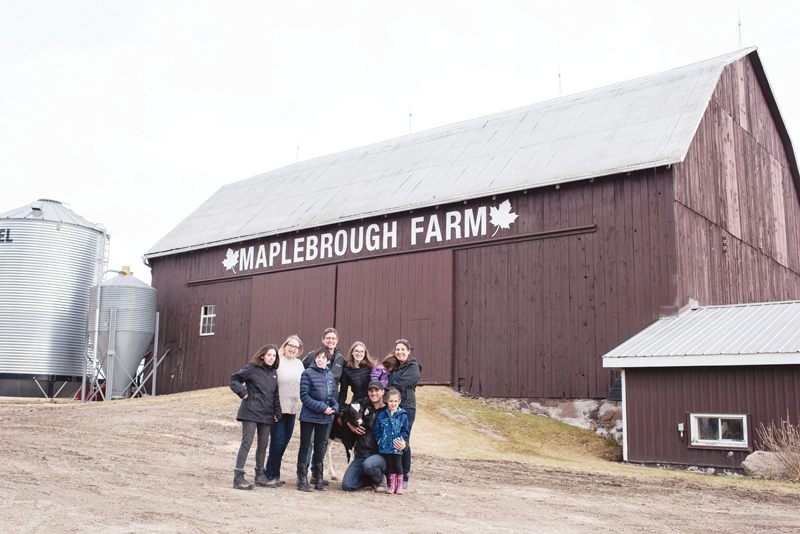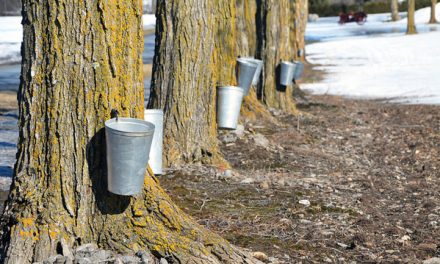The Risebrough Families of Maplebrough Farms, Uxbridge, are a 2019 Recipient of their first Master Breeder Shield. Courtesy photo

Courtesy photo
by Holly McFarlane
AgriNews Contributor
Holstein Canada describes the Master Breeder shield as a highly coveted, prestigious title awarded to the members who have demonstrated the highest level of success in producing herds with elite conformation and production, all while maintaining a high proficiency in reproduction, health and longevity. This year, nineteen Canadian Holstein breeders will be awarded with the Master Breeder Shield. Eastern Ontario is home to one farm that is recognized as a Master Breeder herd; the Risebrough Family of Maplebrough Farm (Durham Region). Three other Ontario farms (Oxford County); Wilmarlea Farm (MacKay Family), Larenwood Farms (McClaren Family) and Darcroft Farms Ltd. (MacLeod Family) are also named 2019 Master Breeders.
Maplebrough Farm
For six generations, the Risebrough name has remained a constant in the farming community local to the Uxbridge area. Today, two generations of Risebroughs currently own and operate Maplebrough Farm; the families of Mike Risebrough and his nephew, Jamie Risebrough. The farm was first purchased in 1951 by Mike’s parents, Gordon and Dorothy, from Gordon’s uncle. In 1968, they officially registered as members with Holstein Canada, bought a few Holsteins, and the Maplebrough prefix was born. In 1992, their son Mike Risebrough, joined as a partner on the farm. Today, Mike continues to farm alongside his wife Susan and their three children, Megan, Hannah and Grace. Jamie Risebrough worked on the farm throughout high school and University. Jamie graduated from his studies in Agriculture at the University of Guelph in 2007 and later became a partner in the farm in 2012. Jamie and his wife Rachel, a veterinarian owning a small animal practice in Uxbridge, have two children, Alexa and Lauren who are keen to learn and help at the farm.
The Risebroughs milk 41 cows with a total herd size of approximately 110 head. Farming 250 acres, they grow almost all of their own forages for feed. The milking herd at Maplebrough is housed in a traditional bank barn with 41 stalls. In 2007, renovation of the barn provided more stall space, increased windows and natural light, and an area retrofitted for calves and heifer pens.
A foundation built for success
The Maplebrough herd traces back to a couple of prominent foundation cows that have left a legacy of sound breeding and productivity through their offspring over the years. Maplebrough Privilege Rose (Leadfield Privilege) who was classified their first excellent cow in 1991, remains central to the heart of the herd. “After learning we were receiving a Master Breeder Shield we started doing research on the herd, 40 per cent of the points for our Master Breeder Shield are a result of her genetics and 20 per cent of today’s herd goes back to Rose,” says Mike. Another cow who remains highly influential in today’s herd is a granddaughter of Rose, Maplebrough Jackpot Rachel VG-86-7YR 4* (Peartome Jackpot). Over her 11 lactations at Maplebrough, Rachel produced over 100,000 kg of milk and has two daughters that have since achieved the same. Leaving her mark on the herd, 28 per cent of the points for the Risebrough’s Master Breeder shield are reflective of her influence.
The purchase of a cow named High Point Rox Ella (Silky Gibson) from High Point Farms in Port Perry, Ont. remains a notable moment as the Risebrough’s traditionally have rarely purchased genetics from off the farm. “Robert Smith told us everyone should own a Roxy!” exclaims Mike with reference to the cow whose 4th dam is Glenridge Citation Roxy EX-8YR-CAN 30*. Rox Ella made her own significant contribution to the Risebrough’s Master Breeder achievement and currently has a variety of milking daughters and granddaughters in the herd today.
The breeding program at Maplebrough is centred predominantly around proven bulls. Genomic sires have more recently been added to the program, offering new variety to available sexed bulls considered for matings. Mike and Jamie share in all breeding decisions and the development of their genetic program. Jamie completes all artificial insemination on-farm, with the majority of cows bred with sexed semen. Sire selection at Maplebrough places heavy emphasis on traits such as + fat, with preference given to sires with double-digit conformation. Bulls such as Crackholm Fever, and more recently Val-Bisson Doorman have had a tremendous impact on the Maplebrough herd.
An equation for success
The Risebroughs don’t take for granted the quality of forages required to achieve high reproductive and productive performance in dairy cattle. “We focus on growing really good, high-quality forages,” says Jamie, “That’s the key to our success. If you put up bad feed, that’s all you have to work with.” Quick to get on the fields some years, the Risebrough’s don’t underestimate the value of an early, high quality, first cut forage that will go the extra mile from a nutritional perspective. In 2006, the feeding program in the dairy herd was moved to a TMR ration. Fungicide application to corn was initiated in 2017. The Risebrough’s have since moved away from barley to straight corn in their feed. The performance of the herd proves their efforts are well worth it as the herd is producing a daily average of 41.2 kg of milk, a 294-289-298 BCA and a herd classification of 11 EX (9 ME), 23 VG and 11 GP.
Growing pains amidst a progressive industry
With growth potential capped off in their current barn, the Risebrough’s must operate with a sharp pencil so to speak. “We try our best to keep all 41 stalls in the barn full; as soon as one cow calves in, another cow that is ready to dry off will move out,” says Jamie with reference to the careful management required to keep their herd producing profitably in an older barn. Replacement animals continue to enter the herd, with a goal of first calving at 22-24 months of age. “Even if they calve in on the small size, we find they often grow significantly throughout that first lactation,” says Mike. Heat detection within the milking herd continues to prove a challenge in the tie-stall setup, and although their conception rate isn’t unacceptable they recognize they could improve in that area.
The ideal cow at Maplebrough demonstrates good production with a great udder and good feet and legs. Mike and Jamie make mating decisions with the goal of breeding an animal that will score 87 points in her second lactation, acknowledging that it doesn’t always happen. Recognizing the importance of longevity within the herd, their primary breeding objective has been to breed and develop a cow that is going to live a long, productive life. “We are very proud of our older cows, but are careful to make early decisions on cows that may not last more than a couple of lactations,” says Mike. With their oldest cow in the barn holding a lifetime milk production record of over 120,000 kgs and currently in-calf with her 9th pregnancy (sexed semen), the Risebrough’s are on the right track!
The largest obstacle the Risebrough’s are currently faced with is the limitations related to their maxed-out barn size. The current bank barn has been retrofitted to its maximum potential, capping the milking herd size at 41 cows. “Determining how you continue to grow, evolve and be prosperous while identifying what that next step will be is key. And, it’s a matter of figuring out when it is the right time to take that next step,” says Jamie.
Reflecting on their achievements
When asked what the Master Breeder Shield represents to him, Jamie quickly responds, “It’s a huge accomplishment, it’s something you have to be proud of! It means you’re achieving balance. To be told you’re one of the best in Canada is pretty amazing. You’re a good manager… you have achieved good production with balanced, functional cows.”
“I used to dream about it a lot,” says Mike, referencing the prestigious Master Breeder award. “You reflect on all of the other local Master Breeders in the area and think ‘Wow, there’s no way we are in the same league as those breeders.’ When you hear you’ve won the award, you’re left in awe. It’s hard to believe that our humble herd has achieved that!”
Striving each year for continued improvement, the success at Maplebrough is built upon three pillars: producing quality feed; continued herd and genetic advancement; and a teamwork approach to all duties on the farm. It has been a magic combination for the Risebrough’s to date, and has proven that success can’t be determined by the age of your barn or the size of your herd, but by the passion and dedication demonstrated by all family members, on the good days and on the hard days. “The Master Breeder Award is such a family-based award – we couldn’t do it without each other!” reflects Mike Risebrough.













